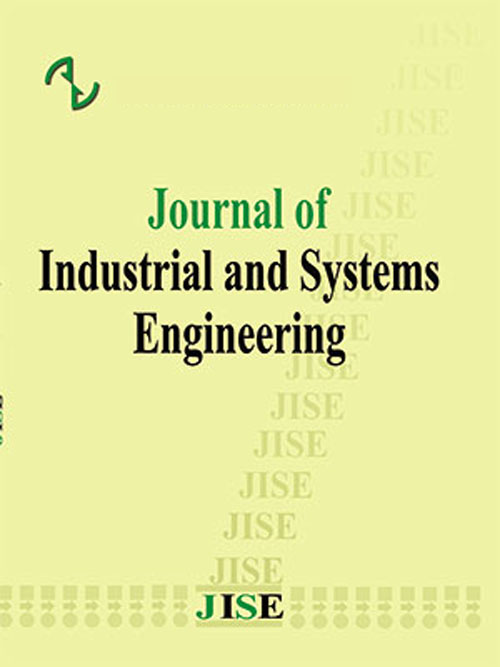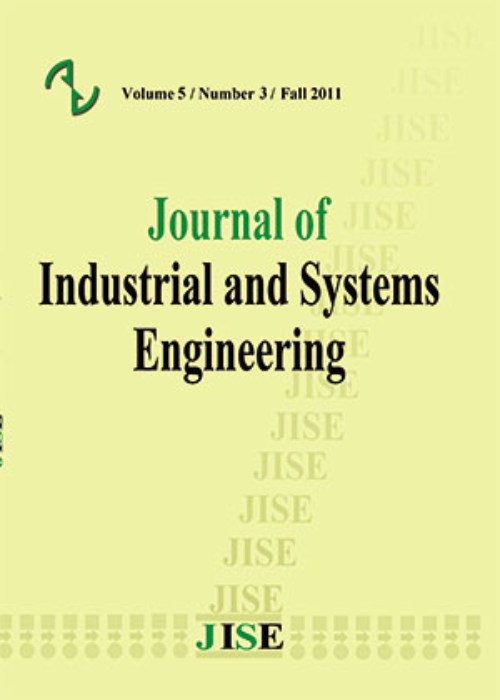فهرست مطالب

Journal of Industrial and Systems Engineering
Volume:8 Issue: 3, Summer 2015
- تاریخ انتشار: 1394/08/15
- تعداد عناوین: 6
-
-
Pages 1-23The most important aim of every project is on time completion, budget consideration and reaching the highest possible quality, based on contract. This paper suggests a methodology for risk management in engineering, procurement, and construction (EPC) projects. Risk management enables project teams to perform with minimum deviation from predetermined goals. The proposed methodology identifies and evaluates critical risks of EPC projects using multi criteria decision making (MCDM) techniques. Then, by the means of developed earned value management (EVM) technique and considering Project Risk index (PRI), this work will proceed to estimate the degree of risk effects on project objectives. The optimal control measures (CMs) to address the risks are found through a goal programming model. The methodology was implemented on a case study in oil and gas industry in Iran. Results of this study show the impact of critical risks on objectives of EPC projects.Keywords: Risk management in EPC projects, Critical risks, MCDM techniques, EVM method, Linear Programming, Control Measures
-
Pages 24-41Covering Tour Problem (CTP) is the generalized form of Traveling Salesman Problem (TSP), which has found different applications in the designing of distribution networks, disaster relief, and transportation routing. The purpose of this problem is to determine the Hamiltoniancyclewiththe lowest costusinga subset of all the nodes, such that the other nodes would be in a distance shorter than the pre-specified one, from at least one visited node. In this paper, two new heuristic algorithms called MDMC and AGENI are offered to solve CTP. In order to assess the performance of the proposed algorithms in small scale, several test problems are accurately solved and the results compared with those from the proposed heuristic algorithms. Also, in large scales, the results of each of proposed algorithms are compared with the three heuristic algorithms existing in the literature. Finally, the effect of neighborhood searcheson the performance of the proposed algorithms will be investigated. The results, show that the performance of the proposed algorithms in small and large scales is appropriate.Keywords: covering tour problem, local search, heuristic methods
-
Pages 42-59In this study a supply chain network design model has been developed considering both forward and reverse flows through the supply chain. Total Cost, environmental factors such as CO2 emission, and social factors such as employment and fairness in providing job opportunities are considered in three separate objective functions. The model seeks to optimize the facility location problem along with determining network flows, type of technology, and capacity of manufacturers. Since the customer’s demand is tainted with high degree of uncertainty, a robust optimization approach is proposed to deal with this important issue. An efficient genetic algorithm is applied to determine the Pareto optimal solutions. Finally, a case study is conducted on steel industry to evaluate the efficiency of the developed model and solution algorithm.Keywords: Supply Chain, reverse logistic, Social Responsibility, Robust Optimization, multi, objective genetic algorithm
-
Pages 60-76Uncertain and stochastic states have been always taken into consideration in the fields of risk management and accident, like other fields of industrial engineering, and have made decision making difficult and complicated for managers in corrective action selection and control measure approach. In this research, huge data sets of the accidents of a manufacturing and industrial unit have been studied by applying clustering methods and association rules as data mining methods. First, the accident data was briefly studied. Then, effective features in an accident were selected while consulting with industry experts and considering production process information. By performing clustering method, data was divided into separate clusters and by using Dunn Index as validator of clustering, optimum number of clusters has been determined. In the next stage, by using the Apriori Algorithm as one of association rule methods, the relations between these fields were identified and the association rules among them were extracted and analyzed. Since managers need precise information for decision making, data mining methods, when to be used properly, may act as a supporting system.Keywords: Accident, data mining, association rules, K, means algorithm, a priori Algorithm
-
Pages 77-94Most of existing researches for multi response optimization are based on regression analysis. However, the artificial neural network can be applied for the problem. In this paper, two approaches are proposed by consideration of both methods. In the first approach, regression model of the controllable factors and S/N ratio of each response has been achieved, then a fuzzy programming has been applied to find the optimal factor's levels. In the second approach, a tuned Artificial Neural Network (ANN) is used to relate controllable factors and overall exponential desirability function then Genetic Algorithm(GA) is used to find factors optimum value. Mentioned approaches have been discussed in a real case study of oil refining industry. Experimental results for the suggested levels confirm efficiency of the both proposed methods; however, the Neural Network based approach shows more suitability in our case study.Keywords: Multi, response optimization, Taguchi Method, Artificial Neural Network, Genetic algorithm, Fuzzy programming
-
Pages 95-113Closed Loop production systems attempt to economic improvement, deliver goods to customers with the best quality, decrease in the return rate of expired material and decrease environmental pollution and energy usage. In this study, we solve a multi product, multi-period closed loop supply chain network in Kalleh dairy company, considering the return rate under uncertainty. The objective of this paper is to develop a supply chain model including raw material suppliers, manufacturers, distributors and a recycle center for returned products. Solving this model helps us to make a good decision about providing materials, production, distribution and recovery. Our basic goal is to estimate optimum return rate of some products such as yoghurt, to production cycle. Once the products pass of their shelf life, they are returned to production cycle. For this study, we develop a linear programming model with a consideration of chance constraints. Finally, this model is implemented by Lingo software with using real data. The obtained results by our model show 9.5 % decrease for total cost in comparison with the current status.Keywords: Closed loop supply chain, Optimization, Multi, Product, Multi, Period


